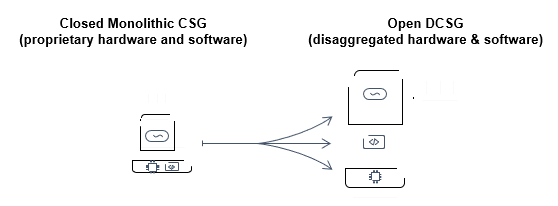Routers have played a part in mobile networks as early as the transition to 3G, and even more so in 4G. But while IP-based traffic has been an integral part of core and backhaul aggregation sites, many cell sites have continued to rely on layer-2 switching.
However, 5G use cases can no longer rely solely on low-cost layer-2 switches at the access network, and the move to layer-3 routing at the cell site level has become essential. Indeed, many of 5G’s advanced services, high capacities and low latencies rely on end-to-end L3 SLA for more efficient traffic handling and more resilient networks.
For years cell site routers (CSRs), also known as cell site gateways (CSGs), have been offered as monolithic solutions by a few large vendors. Relatively expensive, these closed systems combine proprietary hardware and software, thereby decreasing mobile operators’ flexibility and increasing their CAPEX.
With the arrival of 5G, disaggregated cell site routing has emerged as an attractive alternative to this closed approach. Disaggregated routing is an open architecture that decouples the hardware and software elements of CSGs/CSRs. This innovative approach has been fueled by the emergence of Broadcom’s carrier-grade Ethernet switching processors. As a result, multiple vendors are building white-box hardware platforms as a basis for disaggregated cell site gateways (DCSG) with integrated network operating system (NOS) software.

By deploying best-of-breed DCSGs that fit their dynamic needs, network operators are reducing their costs, enhancing their flexibility, and scaling their networks to support the growing demand for 5G-based services. DCSGs enable 5G service providers to avoid vendor lock-in and select among more hardware choices for varying deployment scenarios.
The numbers show that DCSGs are growing in importance with the worldwide expansion and densification of 5G networks, which require more capacity while offering more services. This means operators need to deploy even more sites, gateways and radios, which, in turn, provides a real incentive for operators to deploy cost-effective white-box DCSG solutions. According to global research firm Omdia, DCSGs already accounted for around 10% of all new CSGs in 2021, and are expected to grow rapidly to 25% in 2024.

The move toward DCSGs is supported by a number of industry organizations, including the Telecom Infra Project (TIP). TIP’s Open Optical & Packet Transport (OOPT) Project Group, together with several leading global operators, created the definition of a DCSG as an open white-box cell site gateway device for existing 4G and emerging 5G mobile infrastructures. As a cell site gateway, a DCSG supports layer-2, layer-3 and MPLS features with native time synchronization protocols.
In addition to white-box hardware and NOS software, a DCSG can include other software components to make it suitable for more use cases. Ceragon recently announced our partnership with IP Infusion. This collaboration helped us develop the IP-50FX, the industry’s first radio-aware DCSG, combining two key cell site functions in a single device: a cell site router (CSR) and a radio indoor unit (IDU). Stay tuned as we plan to take a closer look at the IP-50FX in a coming blog post.
Want to know more?


